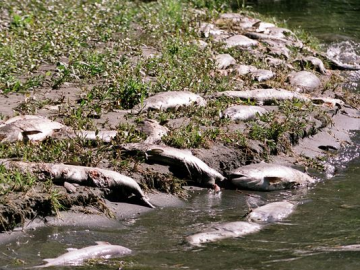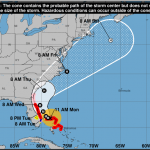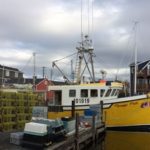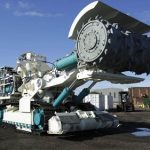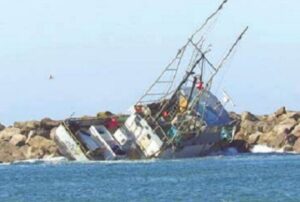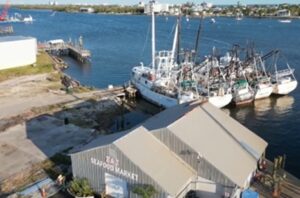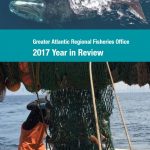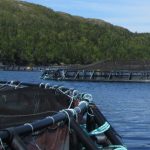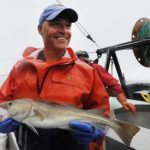Monthly Archives: August 2016
Poor production of pink salmon mystifies
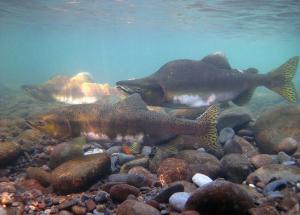 Weather patterns contributed to a screwy sockeye run in 2015, and this year the same is happening to pinks, the second-largest salmon harvest in Alaska. In 2016, commercial fishermen have only harvested 8 million pinks as of Aug. 15 in Prince William Sound, the state’s largest pink run. Only one-third are hatchery fish, a marked turn from last years’ massive pink haul of 96 million in the Sound, a 20-year record-breaker over 93 million pinks in 2003. Of these, 80 percent were hatchery fish. Southeast Alaska’s run is doing as badly with only 13.4 million harvested, less than half the already-substandard forecast of 34 million fish. Dan Gray, the area management biologist for Southeast Alaska’s commercial fisheries, said he and fishermen both are stumped as to the poor run’s nature, but seem to think the warm Gulf of Alaska “blob” of 2015, which raised surface temperatures 2 degrees Celsius, has some impact. “Maybe it wasn’t the best thing for high sea survival,” he said. Hope for a midseason pickup in returns is dim. Read the rest here 21:07
Weather patterns contributed to a screwy sockeye run in 2015, and this year the same is happening to pinks, the second-largest salmon harvest in Alaska. In 2016, commercial fishermen have only harvested 8 million pinks as of Aug. 15 in Prince William Sound, the state’s largest pink run. Only one-third are hatchery fish, a marked turn from last years’ massive pink haul of 96 million in the Sound, a 20-year record-breaker over 93 million pinks in 2003. Of these, 80 percent were hatchery fish. Southeast Alaska’s run is doing as badly with only 13.4 million harvested, less than half the already-substandard forecast of 34 million fish. Dan Gray, the area management biologist for Southeast Alaska’s commercial fisheries, said he and fishermen both are stumped as to the poor run’s nature, but seem to think the warm Gulf of Alaska “blob” of 2015, which raised surface temperatures 2 degrees Celsius, has some impact. “Maybe it wasn’t the best thing for high sea survival,” he said. Hope for a midseason pickup in returns is dim. Read the rest here 21:07
Fisherman’s widow sought to have fishing vessel seized before it sank
 The firm that owns a fishing vessel that sank early Wednesday miles off Mount Desert Island is being sued by the widow of a Westbrook man who died in 2013 after he fell overboard from the vessel during a fishing trip, according to federal court documents. Marcia J. Gorham of Westbrook filed suit against the firm that owns the vessel, Lydia & Maya Inc., in May 2015, according to information posted online in the document database. In the complaint, Gorham alleges that her husband, Martin J. Gorham, died as a result of “the carelessness, negligence and recklessness” of the owners of the Lydia & Maya fishing vessel, which she claims was unseaworthy at the time of her husband’s death off Cape Ann, Massachusetts, on Dec. 19, 2013. Martin Gorham’s mother, Barbara A. Foster, told the Boston Herald in December 2013 that her son had been working on the deck of the Lydia and Maya at around noon when he fell overboard in rough seas without a life jacket. Read the rest here 19:13
The firm that owns a fishing vessel that sank early Wednesday miles off Mount Desert Island is being sued by the widow of a Westbrook man who died in 2013 after he fell overboard from the vessel during a fishing trip, according to federal court documents. Marcia J. Gorham of Westbrook filed suit against the firm that owns the vessel, Lydia & Maya Inc., in May 2015, according to information posted online in the document database. In the complaint, Gorham alleges that her husband, Martin J. Gorham, died as a result of “the carelessness, negligence and recklessness” of the owners of the Lydia & Maya fishing vessel, which she claims was unseaworthy at the time of her husband’s death off Cape Ann, Massachusetts, on Dec. 19, 2013. Martin Gorham’s mother, Barbara A. Foster, told the Boston Herald in December 2013 that her son had been working on the deck of the Lydia and Maya at around noon when he fell overboard in rough seas without a life jacket. Read the rest here 19:13
Video Report: Why Brexit may be the best thing for Britain’s fishing industry
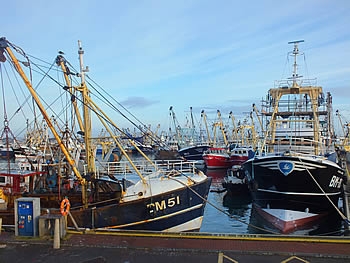 The world was shocked when, in June, the United Kingdom voted to leave the European Union. Many believe the severance will negatively affect Britain’s economy, but the fishing industry expects benefits — including increased profitability, poverty relief and elimination of what some fishermen see as harmful restrictions. From southwest England, special correspondent Jennifer Glasse has the story. The June vote to leave may have surprised many there, but it came as welcome news to the island nation’s fishermen. They have long complained about European Union rules, and now they’re hoping Brexit will help them revitalize a fishing industry they say was damaged by E.U. policy. MIKE SHARP, Skipper, “Emilia Jane”: We have all the Dutch, and the French, and the Belgian fishermen, and mainly the Spanish as well coming to land to take our fish out of our waters, which we want to — you know, I think we still can let them come in, but we can decide how many comes in. Read the rest, watch the video click here 17:50
The world was shocked when, in June, the United Kingdom voted to leave the European Union. Many believe the severance will negatively affect Britain’s economy, but the fishing industry expects benefits — including increased profitability, poverty relief and elimination of what some fishermen see as harmful restrictions. From southwest England, special correspondent Jennifer Glasse has the story. The June vote to leave may have surprised many there, but it came as welcome news to the island nation’s fishermen. They have long complained about European Union rules, and now they’re hoping Brexit will help them revitalize a fishing industry they say was damaged by E.U. policy. MIKE SHARP, Skipper, “Emilia Jane”: We have all the Dutch, and the French, and the Belgian fishermen, and mainly the Spanish as well coming to land to take our fish out of our waters, which we want to — you know, I think we still can let them come in, but we can decide how many comes in. Read the rest, watch the video click here 17:50
All For Sustainability, But Not Monument Expansion
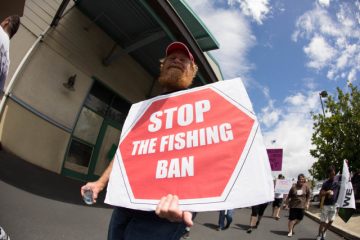 Fish and the ocean are significant to Hawaii’s history and culture. Whether it was fishing from shore or getting a half pound of poke, fish was always apart of my life and now it’s my livelihood. When I first heard of the Papahanaumokuakea National Marine Monument Sanctuary I thought it was a great idea. Protecting the fish, habitats and other marine life is something I stand for. But as I found out more about it, I completely changed my mind. The trend now is to be sustainable — eat sustainable foods and drive cars with sustainable energies. Our Hawaii fishing fleet is an example of fishing sustainably with federal observers onboard, uniquely developed fishing gear and world-renowned handling practices. Strict quotas and GPS tracking on every boat make it nearly impossible to hide anything. Read the rest here 17:26
Fish and the ocean are significant to Hawaii’s history and culture. Whether it was fishing from shore or getting a half pound of poke, fish was always apart of my life and now it’s my livelihood. When I first heard of the Papahanaumokuakea National Marine Monument Sanctuary I thought it was a great idea. Protecting the fish, habitats and other marine life is something I stand for. But as I found out more about it, I completely changed my mind. The trend now is to be sustainable — eat sustainable foods and drive cars with sustainable energies. Our Hawaii fishing fleet is an example of fishing sustainably with federal observers onboard, uniquely developed fishing gear and world-renowned handling practices. Strict quotas and GPS tracking on every boat make it nearly impossible to hide anything. Read the rest here 17:26
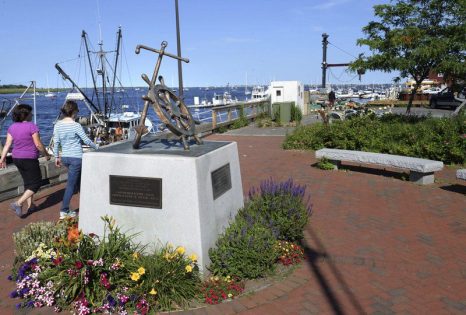
A fitting honor for fishermen – The rededication of the Newburyport Fishermen’s Memorial on Sept. 5.
Veterans of the community’s working waterfront are joining forces to ensure that the upcoming rededication of the fishermen’s monument will pay adequate homage to those who lost their lives at sea. Kate Yeomans, the riverfront educator who wrote a book on the loss of fishermen two decades ago, has been retained as a consultant to the rededication of the Fishermen’s Memorial on Sept. 5. And Paul Hogg, harbormaster and former commercial fisherman, has been supervising the refurbishment of the monument itself. The ceremony, beginning at 9:30 a.m., will commemorate the anniversary of the loss of the fishing vessel Heather Lynne II, a Newburyport-based fishing boat that crossed paths with a tug and barge in the early morning hours off Cape Ann on Sept. 5, 1996. The fishing boat capsized, leading to the loss of the three crewmen. “The re-dedication is an important moment because it honors these men,” said Yeomans, a onetime journalist who wrote the 2003 book, “Dead Men Tapping: The End of the Heather Lynn II.” Read the story here 15:52
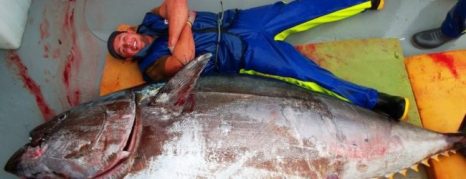
The Pew Calls for Two-Year Ban on Commercial Fishing in Last Effort to Save the Bluefin Tuna
The Pacific bluefin tuna could become extinct if a two-year ban on commercial fishing is not enacted, according to an environmental group. A a recent meeting in Japan, the Pew Charitable Trusts Global Tuna Conservation Program, it was revealed that the current bluefin tuna population is at just 2.6 of it historic size. The stock assessment concluded the world’s largest tuna fishery – located in the western and central Pacific – has been fished down more than 97 percent. “Scientific estimates have indicated that the population of Pacific bluefin tuna is severely depleted. Still, the governments,,, Amanda Nickerson Pew Populations of both Pacific and Atlantic bluefin have been in decline since the 196os. Read the rest here 14:32
Mass Div. of Marine Fisheries benefits from NOAA $240K grant to study leatherback sea turtles off Cape Cod
 National Oceanic and Atmospheric Administration has awarded the Massachusetts Division of Marine Fisheries $240,398 to study leatherback sea turtles off Cape Cod in areas considered to be dense with fishing gear, according to NOAA. The work is expected to provide critical animal behavior and habitat data needed to develop fishing gear that would help address significant leatherback entanglement problems in Massachusetts, according to a statement from NOAA Fisheries Greater Atlantic Region. The award is part of $5.4 million in grants from NOAA in 2016 in all coastal regions to help in the recovery of endangered and threatened marine species. Link 14:12
National Oceanic and Atmospheric Administration has awarded the Massachusetts Division of Marine Fisheries $240,398 to study leatherback sea turtles off Cape Cod in areas considered to be dense with fishing gear, according to NOAA. The work is expected to provide critical animal behavior and habitat data needed to develop fishing gear that would help address significant leatherback entanglement problems in Massachusetts, according to a statement from NOAA Fisheries Greater Atlantic Region. The award is part of $5.4 million in grants from NOAA in 2016 in all coastal regions to help in the recovery of endangered and threatened marine species. Link 14:12
Lobster Council of Canada working with European governments to combat threat to live lobster imports
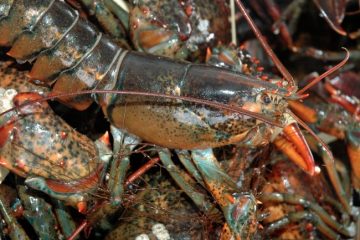 The discovery of several dozen live lobsters in Swedish waters earlier this year is jeopardizing future imports to Europe from North America. In Canada, there is work being done to prevent that move. Geoff Irvine, executive director of the Lobster Council of Canada, says the organization has been working on this issue for months. “We just want everyone to be aware that it is being attacked very aggressively,” he said. The Swedish Agency for Marine and Water Management is spearheading a drive to stop the import of live lobsters from North American exporters. It has asked the European Union to bar these imports. The agency considers the American lobster an alien species in Swedish waters and has satated the lobsters’ presence could introduce new and “very serious diseases and parasites that may affect domestic European lobster and other shellfish.” Read the rest here 10:30
The discovery of several dozen live lobsters in Swedish waters earlier this year is jeopardizing future imports to Europe from North America. In Canada, there is work being done to prevent that move. Geoff Irvine, executive director of the Lobster Council of Canada, says the organization has been working on this issue for months. “We just want everyone to be aware that it is being attacked very aggressively,” he said. The Swedish Agency for Marine and Water Management is spearheading a drive to stop the import of live lobsters from North American exporters. It has asked the European Union to bar these imports. The agency considers the American lobster an alien species in Swedish waters and has satated the lobsters’ presence could introduce new and “very serious diseases and parasites that may affect domestic European lobster and other shellfish.” Read the rest here 10:30
New Bedford Dock-U-Mentaries Film Series continues with Of the Sea: Fishermen, Seafood & Sustainability
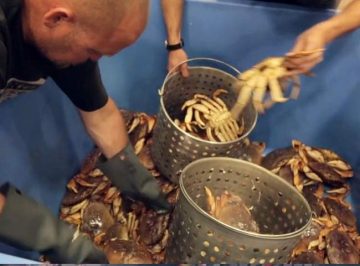 The Dock-U-Mentaries Film Series continues with Of the Sea: Fishermen, Seafood & Sustainability a new documentary film by Mischa Hedges. In the film, we learn from California fishermen about the salmon, black cod, sea urchin, crab and squid fisheries, and the challenges they face. Film maker Mischa Hedges will introduce the film and lead a discussion following the screening. Dock-U-Mentaries is presented by New Bedford Whaling National Historical Park, the New Bedford Fishing Heritage Center, and the Working Waterfront Festival. All programs are open to the public and presented free of charge. See the film at 7 p.m., Aug. 19 at the Corson Maritime Learning Center, 33 William St., New Bedford. Link Watch the film trailer here 09:52
The Dock-U-Mentaries Film Series continues with Of the Sea: Fishermen, Seafood & Sustainability a new documentary film by Mischa Hedges. In the film, we learn from California fishermen about the salmon, black cod, sea urchin, crab and squid fisheries, and the challenges they face. Film maker Mischa Hedges will introduce the film and lead a discussion following the screening. Dock-U-Mentaries is presented by New Bedford Whaling National Historical Park, the New Bedford Fishing Heritage Center, and the Working Waterfront Festival. All programs are open to the public and presented free of charge. See the film at 7 p.m., Aug. 19 at the Corson Maritime Learning Center, 33 William St., New Bedford. Link Watch the film trailer here 09:52
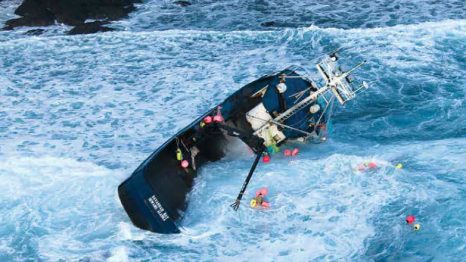
U.S. National Transportation Safety Board Report – Lessons Learned on Fatigue, Voyage Planning, Communication
The U.S. National Transportation Safety Board (NTSB) has released its annual compendium of marine accidents and the lessons learned from them. Safer Seas Digest 2015 (click here for the report) examines 29 major marine casualty investigations the agency closed in 2015. The 72-page report lists some of the lessons learned from the investigations, such as better voyage planning, the need for effective communications and recognizing the peril of crew fatigue. FISHING VESSELS – Blazer page 12, Christopher’s Joy page14, Juno 16 Pacific Queen 18 Savannah Ray 20 Titan 22, MULTIPLE VESSELS – American Dynasty and Winnipeg 26 Eastport Pier (Ada C. Lore, Double Trouble 2, and Medric II) 28 Flag Gangos and Pamisos 30 Gloria May and Capt Le 32 Krystal Sea/Cordova Provider and Sycamore 34 Mesabi Miner and Hollyhock 36 Summer Wind and Miss Susan Tow 38 Read the rest here 08:40
Next Dungeness crab season remains murky while fishermen are optimistic
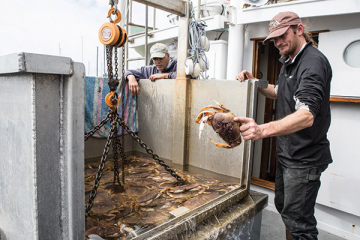 After an algae-produced neurotoxin significantly curtailed the last Dungeness crab season, commercial anglers are glad to hear that the upcoming season won’t be spoiled — at least not to the same extent. “We’re not going to see closures of the entire state,” said Raphael Kudela, an ocean sciences professor at the University of California, Santa Cruz. Ben Platt, a crab fishermen who docks his boat at Pillar Point Harbor, said in email to the Review that he and others were feeling optimistic that the domoic acid would not interfere with the start of this year’s season. “We are all hopeful that our season will start as normal on Nov. 15 in Central California based on the overall cooler water temperatures off our coast,” he wrote. “We were able to have a limited season last spring and get people used to buying and eating crab again. “Many of our fishing families were able to get back to work and start paying their bills again,” he said. Read the story here 19:35
After an algae-produced neurotoxin significantly curtailed the last Dungeness crab season, commercial anglers are glad to hear that the upcoming season won’t be spoiled — at least not to the same extent. “We’re not going to see closures of the entire state,” said Raphael Kudela, an ocean sciences professor at the University of California, Santa Cruz. Ben Platt, a crab fishermen who docks his boat at Pillar Point Harbor, said in email to the Review that he and others were feeling optimistic that the domoic acid would not interfere with the start of this year’s season. “We are all hopeful that our season will start as normal on Nov. 15 in Central California based on the overall cooler water temperatures off our coast,” he wrote. “We were able to have a limited season last spring and get people used to buying and eating crab again. “Many of our fishing families were able to get back to work and start paying their bills again,” he said. Read the story here 19:35
R.I. Clammer Dan Briggs concerned about wastewater plant chlorine killing steamers in Narragansett Bay
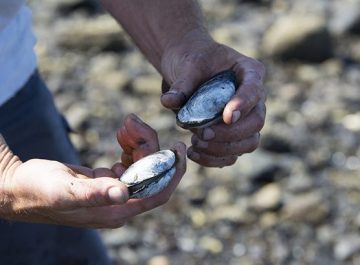 Dan Briggs is afraid he’s losing his job. That explains his angry posts to social media this summer. His venting, however, isn’t doing anything to solve the problem, but at least his boss doesn’t mind. For the past 20 years, the South Kingstown resident has run a one-man commercial operation that sells streamers — dug by hand, with help from a short rake — from tidal areas throughout Narragansett Bay. The soft-shell clams he’s digging up now — far fewer than he was a dozen years ago — often don’t look right, at least when it comes to the color of their shells. He stopped eating his own catch several years ago. “I know this is bad advertising for my business, but I want the bay cleaned up,” said Briggs, who comes from a long line of quahoggers and diggers. “I just want a cleaner bay, a better protected bay, so I can keep my job and sell high-quality shellfish. But we don’t care about cleaning up spots; we just cover our asses and close them to shellfishing.” “Chlorine is killing them,” Briggs said. “There must be other ways to treat our sewage than dump it in the bay. I’m not a scientist, but there must be a better way to collect and treat our sewage.” Read this important article here 15:08
Dan Briggs is afraid he’s losing his job. That explains his angry posts to social media this summer. His venting, however, isn’t doing anything to solve the problem, but at least his boss doesn’t mind. For the past 20 years, the South Kingstown resident has run a one-man commercial operation that sells streamers — dug by hand, with help from a short rake — from tidal areas throughout Narragansett Bay. The soft-shell clams he’s digging up now — far fewer than he was a dozen years ago — often don’t look right, at least when it comes to the color of their shells. He stopped eating his own catch several years ago. “I know this is bad advertising for my business, but I want the bay cleaned up,” said Briggs, who comes from a long line of quahoggers and diggers. “I just want a cleaner bay, a better protected bay, so I can keep my job and sell high-quality shellfish. But we don’t care about cleaning up spots; we just cover our asses and close them to shellfishing.” “Chlorine is killing them,” Briggs said. “There must be other ways to treat our sewage than dump it in the bay. I’m not a scientist, but there must be a better way to collect and treat our sewage.” Read this important article here 15:08
UNO awarded $232,500 grant to design device that protects sea turtles from being captured in small shrimping nets
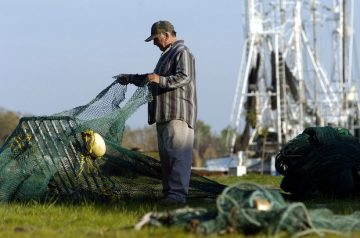 The University of New Orleans has been awarded a $232,500 grant to design a device that protects sea turtles from being captured in small shrimping nets. Federal law has long required shrimpers to use turtle excluder devices, or TEDS, in their nets, but the technology has been limited to use by shrimpers using vessels longer than 25-feet with nets designed for fishing deeper waters. Associate professor of earth and environmental sciences, Martin O’Connell, says shrimpers using smaller nets in shallower waters inshore have no options that enable them to keep the shrimp in and the turtles out. Most sea turtle species have been classified as threatened or endangered since 1978. Data suggests the primary cause of sea turtle death is incidental capture in U.S. shrimp trawls. Link 14:36
The University of New Orleans has been awarded a $232,500 grant to design a device that protects sea turtles from being captured in small shrimping nets. Federal law has long required shrimpers to use turtle excluder devices, or TEDS, in their nets, but the technology has been limited to use by shrimpers using vessels longer than 25-feet with nets designed for fishing deeper waters. Associate professor of earth and environmental sciences, Martin O’Connell, says shrimpers using smaller nets in shallower waters inshore have no options that enable them to keep the shrimp in and the turtles out. Most sea turtle species have been classified as threatened or endangered since 1978. Data suggests the primary cause of sea turtle death is incidental capture in U.S. shrimp trawls. Link 14:36
Athearn Marine Agency Boat of the Week: 35′ Young Bros. Tuna, 460HP 6 Cylinder Lugger,5 KW Northern Lights Genset
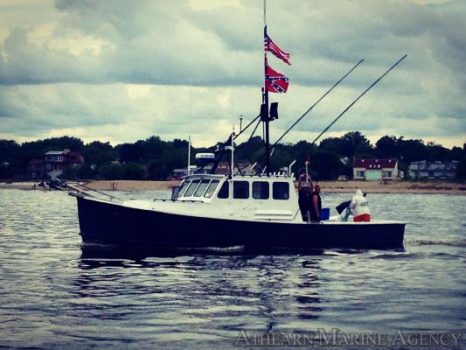 Specifications, information and 17 photo’s click here To see all the boats in this series, Click here 12:09
Specifications, information and 17 photo’s click here To see all the boats in this series, Click here 12:09
Fishermen catch a 1,076 pound Mako, second-largest shark ever from Nova Scotia waters
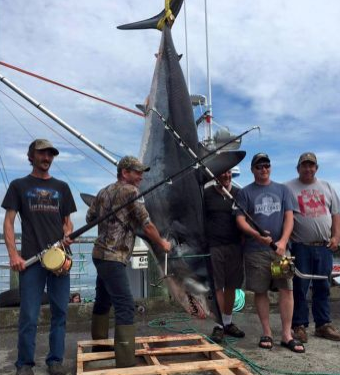 It was a big year for the Lockeport Sea Derby with big sharks and a big turnout. There were a few records set including the biggest shark to ever be caught at the derby and a record number of people attending the event. Dylan Foote, co-ordinator of the event – which was celebrating it’s 25th year – said the derby was the most successful to date. A Mako shark caught during the derby was the second largest recorded shark ever caught in Nova Scotia waters at 1,076 pounds. It was only three pounds lighter than a shark caught in Yarmouth many years ago. “I wish we could have beat it,” said Foote. Lobsterman Marshal Bower, captain of the High Interest out of Lockeport, caught the 11-foot, 10-inch shark. Department of Fisheries and Oceans staff cut open the belly and found two seals and a porpoise. The DFO officials said a shark that size could swim 70 kilometres per hour. Read the story here 11:21
It was a big year for the Lockeport Sea Derby with big sharks and a big turnout. There were a few records set including the biggest shark to ever be caught at the derby and a record number of people attending the event. Dylan Foote, co-ordinator of the event – which was celebrating it’s 25th year – said the derby was the most successful to date. A Mako shark caught during the derby was the second largest recorded shark ever caught in Nova Scotia waters at 1,076 pounds. It was only three pounds lighter than a shark caught in Yarmouth many years ago. “I wish we could have beat it,” said Foote. Lobsterman Marshal Bower, captain of the High Interest out of Lockeport, caught the 11-foot, 10-inch shark. Department of Fisheries and Oceans staff cut open the belly and found two seals and a porpoise. The DFO officials said a shark that size could swim 70 kilometres per hour. Read the story here 11:21
How Cat Poop Is Killing the Endangered Hawaiian Monk Seals
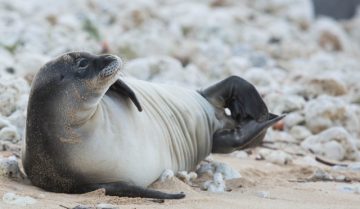 Colonies of feral cats are thriving in neighborhoods all over Oahu, from the University of Hawaii’s Manoa campus to Waianae’s homeless encampment, in alleys behind hotels and along trails in the mountains. But it’s not the smells or caterwauling that is of primary concern to scientists. The biggest issue, federal and state scientists said, is the cats’ unique ability to spread toxoplasmosis, a parasitic disease that has killed at least eight critically endangered Hawaiian monk seals, two spinner dolphins, nene geese and native birds over the past 15 years. The problem is pitting scientists trying to save threatened marine mammals and other creatures against animal rights activists trying to save abandoned cats. “You need to stop it at the source, and that means preventing cats from defecating in the environment, whether it’s in the hills or on the beaches,” said Michelle Barbieri, a wildlife veterinary medical officer with the National Oceanic and Atmospheric Administration’s Hawaiian Monk Seal Research Program. Read the story here 10:24
Colonies of feral cats are thriving in neighborhoods all over Oahu, from the University of Hawaii’s Manoa campus to Waianae’s homeless encampment, in alleys behind hotels and along trails in the mountains. But it’s not the smells or caterwauling that is of primary concern to scientists. The biggest issue, federal and state scientists said, is the cats’ unique ability to spread toxoplasmosis, a parasitic disease that has killed at least eight critically endangered Hawaiian monk seals, two spinner dolphins, nene geese and native birds over the past 15 years. The problem is pitting scientists trying to save threatened marine mammals and other creatures against animal rights activists trying to save abandoned cats. “You need to stop it at the source, and that means preventing cats from defecating in the environment, whether it’s in the hills or on the beaches,” said Michelle Barbieri, a wildlife veterinary medical officer with the National Oceanic and Atmospheric Administration’s Hawaiian Monk Seal Research Program. Read the story here 10:24
Louisiana: Shrimp season starts slowly in local waters
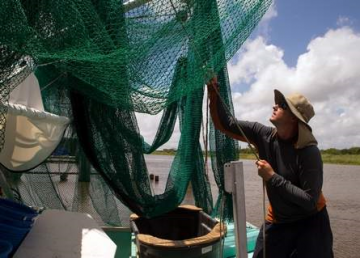 Fall shrimp season has gotten off to a slow start in area waters, fishermen and wholesalers say. The season opened at 6 Monday morning in Louisiana’s inshore waters, within three miles of the coast. east of the Atchafalaya River.Prices have been low in recent years, now about 80-90 cents per pound for small shrimp and $1.50 a pound for larger ones at the sheds. In past years, before a wave of farm-raised shrimp drove down prices, local fishermen could earn as much as $4.50 a pound for larger shrimp. Former commercial shrimper Timmy Melancon was born and raised in Leeville. He built his boat 35 years ago, but now the small hauls and low prices have made him lay off commercial shrimping. On Tuesday, he brought in a 200-pound haul of live shrimp that will mostly be used for fishing bait, and he even gave some away to family and friends since the prices are so low. Guy Duet, who owns the boat Mr. Magoo, had a little more luck shrimping north of Grand Isle. Duet and his crew hauled in about 1,200 pounds of shrimp, but they were mostly small. Read the story here 09:03
Fall shrimp season has gotten off to a slow start in area waters, fishermen and wholesalers say. The season opened at 6 Monday morning in Louisiana’s inshore waters, within three miles of the coast. east of the Atchafalaya River.Prices have been low in recent years, now about 80-90 cents per pound for small shrimp and $1.50 a pound for larger ones at the sheds. In past years, before a wave of farm-raised shrimp drove down prices, local fishermen could earn as much as $4.50 a pound for larger shrimp. Former commercial shrimper Timmy Melancon was born and raised in Leeville. He built his boat 35 years ago, but now the small hauls and low prices have made him lay off commercial shrimping. On Tuesday, he brought in a 200-pound haul of live shrimp that will mostly be used for fishing bait, and he even gave some away to family and friends since the prices are so low. Guy Duet, who owns the boat Mr. Magoo, had a little more luck shrimping north of Grand Isle. Duet and his crew hauled in about 1,200 pounds of shrimp, but they were mostly small. Read the story here 09:03
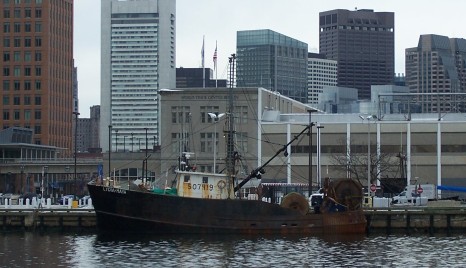
Coast Guard rescues 4 Fishermen off Maine coast
The Coast Guard rescued four fishermen Wednesday morning after the fishing vessel Lydia & Maya started taking on water about 40 miles south of Southwest Harbor, Maine. At about midnight, Coast Guard Sector Northern New England watchstanders received a broken transmission from a crew member aboard the 71-foot vessel saying they were taking on water. Shortly after, an Emergency Position Indicating Radio Beacon alert was sounded, notifying watchstanders the crew was in the water. Coast Guard Station Southwest Harbor launched a 47-foot boat crew, and Air Station Cape Cod launched a MH-60 Jayhawk helicopter crew. Using the EPIRB distress signal to locate the fishermen, the helicopter crew arrived on scene at about 2 a.m. to find four people in a life raft shooting off flares and using a signal light. The rescue swimmer was deployed, and all four fishermen were airlifted into the helicopter. The crew was suffering mild hypothermic conditions. They were taken to Bar Harbor airport to awaiting Emergency Medical Services. The condition of the fishing vessel is still under investigation. Link 07:21
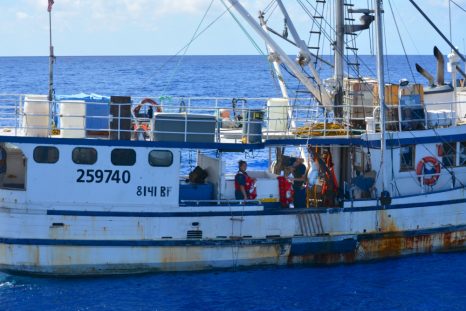
Coast Guard terminates voyages of 3 commercial fishing vessels for safety violations off Oahu
The crew of the USCGC Galveston Island (WPB-1349) terminated the voyages of the 79-foot Lady Jackie, the 62-foot commercial fishing vessel Blue Sky and the 82-foot Jennifer Lynn for hazardous conditions and safety violations during a boardings off Honolulu since Aug. 8. All three vessels were escorted by the Galveston Island crew to the pier in Honolulu. Coast Guard Sector Honolulu personnel are attending the vessels to ensure all discrepancies are rectified prior to any new voyages. The boarding team from the cutter found discrepancies aboard the vessels including inoperable high water alarms, inoperable and/or expired survival craft, expired distress signals, an expired emergency position indicating radio beacon, a lack of or unserviceable life jackets, crews untrained in first aid or emergency procedures and a failure to conduct regular drills. In one case there was excessive fuel in the bilge and in another the vessel’s commercial fishing vessel safety decal and their registration are both expired. More images, read the rest here 18:54
B.C. Commercial Crab Harvester Fined $20,000 for Fishing in a Closed Contaminated Area
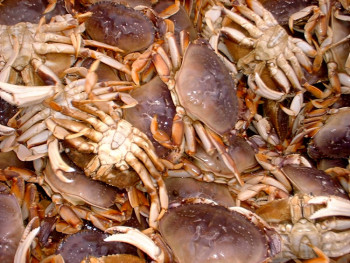 On July 20, 2016, Burnaby resident Danny My Ho pleaded guilty to four violations of the Fisheries Act in Sechelt Provincial Court. The Honourable Judge Steven Merrick fined Mr. Ho $20,000 for fishing for Dungeness crab in an area closed to commercial crab harvesting due to dioxin contamination. The charges stem from Mr. Ho’s fishing activities in Howe Sound during August 2015, as skipper of the commercial crabbing vessel the New Star. On October 9, 2015, a DFO resource management biologist requested that Conservation and Protection fishery officers investigate the fishing records of the New Star. A subsequent inspection of the vessel’s electronic monitoring data and logbook revealed that Mr. Ho was harvesting commercial crab between August 15 and 26 up to one kilometer inside an area closed due to dioxin contamination near Roberts Creek and the Trail Islands on the Sunshine Coast. Read the rest here 17:06
On July 20, 2016, Burnaby resident Danny My Ho pleaded guilty to four violations of the Fisheries Act in Sechelt Provincial Court. The Honourable Judge Steven Merrick fined Mr. Ho $20,000 for fishing for Dungeness crab in an area closed to commercial crab harvesting due to dioxin contamination. The charges stem from Mr. Ho’s fishing activities in Howe Sound during August 2015, as skipper of the commercial crabbing vessel the New Star. On October 9, 2015, a DFO resource management biologist requested that Conservation and Protection fishery officers investigate the fishing records of the New Star. A subsequent inspection of the vessel’s electronic monitoring data and logbook revealed that Mr. Ho was harvesting commercial crab between August 15 and 26 up to one kilometer inside an area closed due to dioxin contamination near Roberts Creek and the Trail Islands on the Sunshine Coast. Read the rest here 17:06
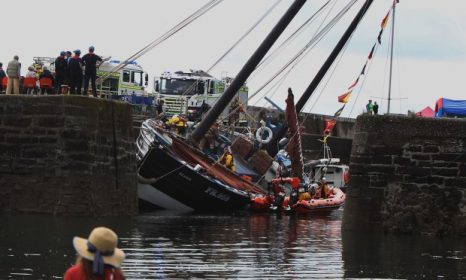
Ancient fishing vessel Reaper will sail south to Arbroath for repairs following salvage operation
The Reaper is upright again following a salvage operation after it keeled over on to its side in Johnshaven harbour on August 6. Canvas patches have been applied to the damaged side of the Fraserburgh-built vessel to keep the water out for her journey to Arbroath. John Firn, vice-chairman of the Anstruther-based Scottish Fisheries Museum, which owns the boat, said the Reaper will be out of commission for the rest of the year. He said: “It has been made waterproof and brought back to normality. The 70-foot Reaper, which dates back to 1902, keeled over with members of the public onboard at the Johnshaven Fish Festival. The strong gust of wind caught the sails and threw one of the six crew overboard on to the harbour floor. Read the rest here 16:30
Blue Harvest Fisheries will acquire the assets of High Liner’s scallop business along with its facility in New Bedford
 Canada-listed High Liner Foods has agreed to sell its scallop business to US group Blue Harvest Fisheries. Under the terms of the deal, Blue Harvest will acquire the assets of High Liner’s scallop business, along with its facility in New Bedford, Massachusetts. High Liner will receive cash proceeds of US$8m for the business and facility, plus additional amounts for scallop inventories. High Liner said it will continue to offer scallops to its customers through a supply agreement with Blue Harvest. The transaction is expected to close within the next several weeks. High Liner had announced in February it would stop value-added fish operations at the New Bedford facility to reduce excess capacity across its production network in North America. Blue Harvest was formed last year with the acquisition of eight Virginia-based scallop vessels and related shore assets from US scallop fishing firm Peabody Corporation. Its acquisition of the High Liner asset is the third Bue Harvest has made in 2016. Read the rest here 14:20
Canada-listed High Liner Foods has agreed to sell its scallop business to US group Blue Harvest Fisheries. Under the terms of the deal, Blue Harvest will acquire the assets of High Liner’s scallop business, along with its facility in New Bedford, Massachusetts. High Liner will receive cash proceeds of US$8m for the business and facility, plus additional amounts for scallop inventories. High Liner said it will continue to offer scallops to its customers through a supply agreement with Blue Harvest. The transaction is expected to close within the next several weeks. High Liner had announced in February it would stop value-added fish operations at the New Bedford facility to reduce excess capacity across its production network in North America. Blue Harvest was formed last year with the acquisition of eight Virginia-based scallop vessels and related shore assets from US scallop fishing firm Peabody Corporation. Its acquisition of the High Liner asset is the third Bue Harvest has made in 2016. Read the rest here 14:20
Menhaden aren’t being ‘decimated’ – Ronnie Sheldon, Pascagoula
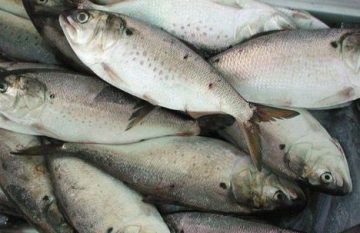 Lately, I’ve read several opinion articles about the menhaden fishery and problems with Omega Protein. I’m a lifelong resident of Pascagoula and a sport fisherman. I have no connections or interests in Omega Protein, but most of my spare time is spent fishing for trout and redfish, and I typically fish the same area (Round Island) where Omega Protein fishes for menhaden. I have no issue with menhaden fishing. Their industry provides hundreds of jobs and pumps millions of dollars into our local economy. Indirectly, their product helps provide food for many as animal feed. Their bycatch is closely regulated and very small. I’ve never personally seen evidence of any bycatch dumped overboard. Read the letter here 13:19
Lately, I’ve read several opinion articles about the menhaden fishery and problems with Omega Protein. I’m a lifelong resident of Pascagoula and a sport fisherman. I have no connections or interests in Omega Protein, but most of my spare time is spent fishing for trout and redfish, and I typically fish the same area (Round Island) where Omega Protein fishes for menhaden. I have no issue with menhaden fishing. Their industry provides hundreds of jobs and pumps millions of dollars into our local economy. Indirectly, their product helps provide food for many as animal feed. Their bycatch is closely regulated and very small. I’ve never personally seen evidence of any bycatch dumped overboard. Read the letter here 13:19
Fishermen warned against fishing in Lake Victoria while drunk
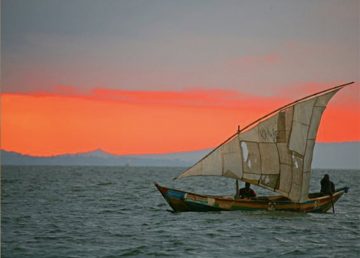 Fishermen in Bondo, Siaya County have been warned against going to fish in Lake Victoria while drunk. Speaking in Bondo Town on Monday, Bondo Beach Management Unit (BMU) Network secretary Mr Joseph Ogwel advised fishermen to observe safety precautions while going about their business to avert accidents on the lake, adding that they will arrest and prosecute any fisherman who will be found on the lake drunk or lacking proper protective gear. The BMU Network secretary regretted the high number of fishermen who have died on the lake due to the lack of proper protective gear, and impressed upon them to always put on life jackets while on the lake. (and lay off the sauce!) Read the rest here 11:22
Fishermen in Bondo, Siaya County have been warned against going to fish in Lake Victoria while drunk. Speaking in Bondo Town on Monday, Bondo Beach Management Unit (BMU) Network secretary Mr Joseph Ogwel advised fishermen to observe safety precautions while going about their business to avert accidents on the lake, adding that they will arrest and prosecute any fisherman who will be found on the lake drunk or lacking proper protective gear. The BMU Network secretary regretted the high number of fishermen who have died on the lake due to the lack of proper protective gear, and impressed upon them to always put on life jackets while on the lake. (and lay off the sauce!) Read the rest here 11:22
North Carolina Fisheries Association Weekly Update for August 15, 2016
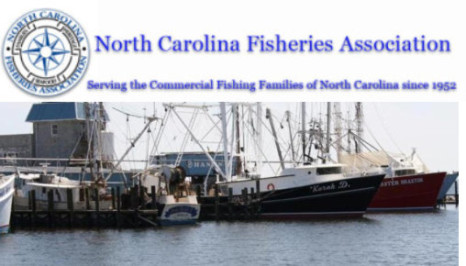 Click here to read the Weekly Update, to read all the updates, Click here 11:03
Click here to read the Weekly Update, to read all the updates, Click here 11:03
Sweden is not backing down on ‘invasive species’ ban of Canada-U.S. lobster
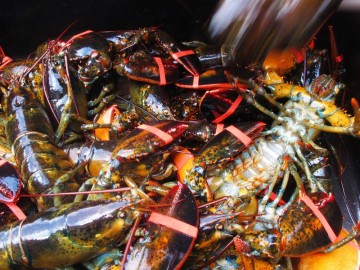 Sweden is not backing away from its campaign to ban the import of live lobsters into the European Union arguing a “precautionary approach” justifies its claim that the presence of North American lobsters in European waters constitutes an invasive species risk. In late July, the Swedish agency issued its rebuttal to Canadian and U.S. scientists who have dismissed its risk assessment as unscientific, unjustified and in one instance “absurd.” “Prevention is generally more environmentally desirable and cost-effective than reaction after the fact,” the Swedish Agency for Marine and Water Management said in its July 29 response. Sweden says 32 American lobsters were captured in its waters between 2008 and 2015. Between 1999 and 2015, 29 were captured off the coast of Norway, including two females carrying hybrid eggs. In Britain, 26 lobsters were caught between 1988 and 2011. In 2015, 361 live American lobsters were released off Britain as the result of Buddhist faith based acts, 133 have been recaptured, according to the Swedes. Read the rest here 10:10
Sweden is not backing away from its campaign to ban the import of live lobsters into the European Union arguing a “precautionary approach” justifies its claim that the presence of North American lobsters in European waters constitutes an invasive species risk. In late July, the Swedish agency issued its rebuttal to Canadian and U.S. scientists who have dismissed its risk assessment as unscientific, unjustified and in one instance “absurd.” “Prevention is generally more environmentally desirable and cost-effective than reaction after the fact,” the Swedish Agency for Marine and Water Management said in its July 29 response. Sweden says 32 American lobsters were captured in its waters between 2008 and 2015. Between 1999 and 2015, 29 were captured off the coast of Norway, including two females carrying hybrid eggs. In Britain, 26 lobsters were caught between 1988 and 2011. In 2015, 361 live American lobsters were released off Britain as the result of Buddhist faith based acts, 133 have been recaptured, according to the Swedes. Read the rest here 10:10
I dream of a federal government that doesn’t overreach
 Most people associate Cape Canaveral with NASA and the Kennedy Space Center, but many licensed commercial fishermen and crabbers in Merritt Island rely on the waters of Florida’s “Space Coast” to earn a living and to support their way of life. Our friendly federal government has decided to threaten that way of life, for reasons that leave much to be desired. A trip down memory lane to the “Space Age” provides background for this ongoing story of government overreach. In 1961, NASA announced its plan to acquire Florida land for the “Space Race” with the Soviet Union, and NASA received a great deal of submerged land in the Space Coast area from the state, including a well-known fishing spot known as “Mosquito Lagoon.” The took charge, and the government then created Merritt Island National Refuge and Canaveral National Seashore. At that time, the federal government respected the right to earn a living and it did not interfere with those making a living fishing the waters in those parks. Not so anymore, of course. Read the rest here 09:11
Most people associate Cape Canaveral with NASA and the Kennedy Space Center, but many licensed commercial fishermen and crabbers in Merritt Island rely on the waters of Florida’s “Space Coast” to earn a living and to support their way of life. Our friendly federal government has decided to threaten that way of life, for reasons that leave much to be desired. A trip down memory lane to the “Space Age” provides background for this ongoing story of government overreach. In 1961, NASA announced its plan to acquire Florida land for the “Space Race” with the Soviet Union, and NASA received a great deal of submerged land in the Space Coast area from the state, including a well-known fishing spot known as “Mosquito Lagoon.” The took charge, and the government then created Merritt Island National Refuge and Canaveral National Seashore. At that time, the federal government respected the right to earn a living and it did not interfere with those making a living fishing the waters in those parks. Not so anymore, of course. Read the rest here 09:11
OffshoreMW enlists New Bedford’s Jim Kendall as fishing industry rep
 An offshore wind developer hired a longtime local fisherman as its fisheries representative Friday, and another developer’s survey boat could arrive at the Marine Commerce Terminal on Saturday, as the offshore wind industry continues to ramp up on SouthCoast after Monday’s signing of landmark energy legislation in Boston. Erich Stephens, executive vice president of New Jersey-based wind power developer OffshoreMW, said longtime local fisherman and industry advocate Jim Kendall will be OffshoreMW’s fisheries representative. Kendall, now executive director of New Bedford Seafood Consulting, is a former scalloper with more than 50 years of experience in the industry. “His job is to make sure we’re hearing from the fishing industry,” Stephens said. Stephens said OffshoreMW previously hired Kendall several years ago, to provide guidance as the company looked at potential lease areas for turbine development in federal waters south of Martha’s Vineyard. OffshoreMW now is one of three companies with leases in that region of ocean waters. Kendall said the new, contract agreement was finalized Friday. “My main concern is trying to minimize any impacts on the fishing industry, and anything that’s going to either disrupt their work or endanger them,” Kendall said. Read the rest here 08:49
An offshore wind developer hired a longtime local fisherman as its fisheries representative Friday, and another developer’s survey boat could arrive at the Marine Commerce Terminal on Saturday, as the offshore wind industry continues to ramp up on SouthCoast after Monday’s signing of landmark energy legislation in Boston. Erich Stephens, executive vice president of New Jersey-based wind power developer OffshoreMW, said longtime local fisherman and industry advocate Jim Kendall will be OffshoreMW’s fisheries representative. Kendall, now executive director of New Bedford Seafood Consulting, is a former scalloper with more than 50 years of experience in the industry. “His job is to make sure we’re hearing from the fishing industry,” Stephens said. Stephens said OffshoreMW previously hired Kendall several years ago, to provide guidance as the company looked at potential lease areas for turbine development in federal waters south of Martha’s Vineyard. OffshoreMW now is one of three companies with leases in that region of ocean waters. Kendall said the new, contract agreement was finalized Friday. “My main concern is trying to minimize any impacts on the fishing industry, and anything that’s going to either disrupt their work or endanger them,” Kendall said. Read the rest here 08:49
Bait Relief! Maine Pogy fishery reopens with strict new rules
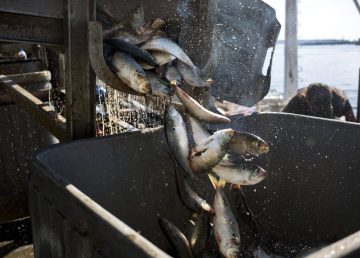 Maine made bait fishermen and lobstermen happy Monday when it reopened its pogy fishery after concluding there is still enough menhaden left in the Gulf of Maine to keep the population healthy. Those who hunt for nearshore schools of the flat, oily-fleshed silver fish – the second most popular lobster bait in Maine after herring – must follow strict new rules to prevent unusual damage or imminent depletion of the Atlantic menhaden. If they limit their fishing days to three and their catch to no more than 120,000 pounds a week, Maine fishermen can use up the remaining 2.3 million-pound quota allotted to Maine, Rhode Island and New York during a so-called “episodic” fishing event, when pogies are deemed unusually plentiful in New England waters. Read the rest here 08:08
Maine made bait fishermen and lobstermen happy Monday when it reopened its pogy fishery after concluding there is still enough menhaden left in the Gulf of Maine to keep the population healthy. Those who hunt for nearshore schools of the flat, oily-fleshed silver fish – the second most popular lobster bait in Maine after herring – must follow strict new rules to prevent unusual damage or imminent depletion of the Atlantic menhaden. If they limit their fishing days to three and their catch to no more than 120,000 pounds a week, Maine fishermen can use up the remaining 2.3 million-pound quota allotted to Maine, Rhode Island and New York during a so-called “episodic” fishing event, when pogies are deemed unusually plentiful in New England waters. Read the rest here 08:08






